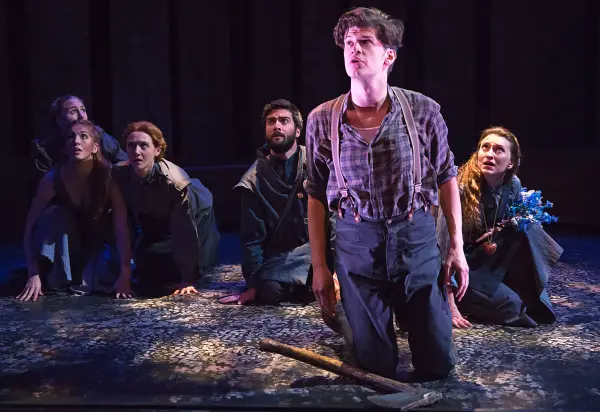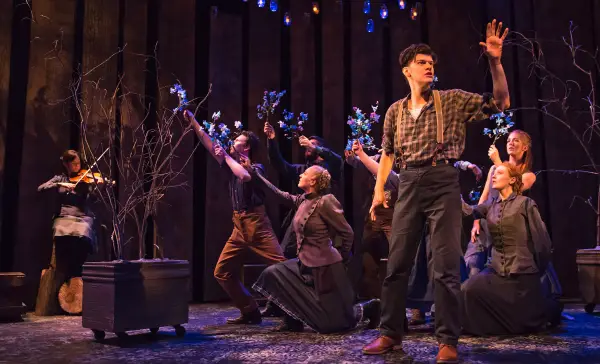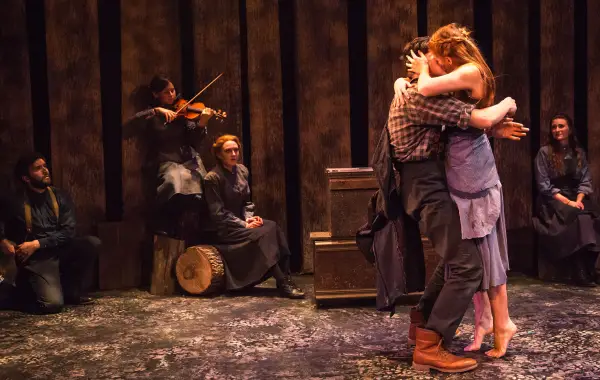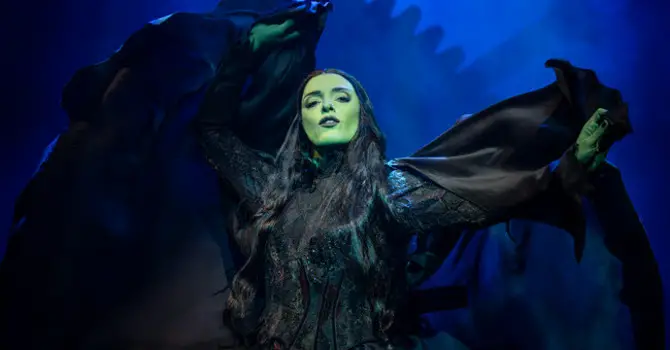Late on a winter afternoon in the vacant downstairs lobby of NYC’s New World Stages, the overhead lights strike me as a bit too bright, the space too vast. But maybe that’s my memory playing tricks on me. Maybe I’m still under the spell cast by the intimate twilight of The Woodsman, which will begin its Monday night performance in three or so hours a few feet from where I’m sitting.

James Ortiz as Nick Chopper with the ensemble of The Woodsman. Photo by Matthew Murphy, 2016.
I had seen the show six days earlier and returned to interview James Ortiz, the creative force behind this visually and emotionally striking backstory of the Tin Man. The story comes culled from Frank L. Baum’s The Wonderful Wizard of Oz and is presented by a brilliant ensemble company of actors, actor/puppeteers, a violinist, and Japanese Bunraku-style puppets. (The terrific music is by Edward W. Hardy, with lyrics by Jennifer Loring.)
“The book was first read to me as a child and I was immediately struck by how wildly different it was from the movie—a different animal altogether—more real and more magical,” says Ortiz, whose multitask gene idles in overdrive: in addition to coming up with the concept for The Woodsman, he plays the role of Nick Chopper, created the set and puppet design, and co-directed with Claire Karpen. “Even then—and of course as I grew older—the book spoke to me theatrically through things like inventive theatre and puppetry...things that aren’t an obvious fit onstage.”


James Ortiz as Nick Chopper with the ensemble of The Woodsman. Photo by Matthew Murphy, 2016.
His desire to be true to the original text (and refute at least a couple of the cinematic liberties taken in the classic MGM film, like the “ruby” slippers which are silver in the book—“Why go to films when you have so much source material in the books?”) inspired Ortiz to take on all 14 of Baum’s Oz books to extract whatever bits and pieces of the Tin Man’s origin the author had slipped into the narrative. And as he pored over the material, Ortiz was also inspired to incorporate Baum’s era, mid-1800s to early 1900s, into the production.
“These Oz stories, they’re the only early American fairy tales we’ve got, so it was important we incorporate that time, and the rustic framework, into the show,” he says. “You can see it in the costume design, and in the way the violin...fiddle...music pulls you into the period.”
That ambience is evident not only on stage but in the theatre itself. Lining the walls are tiles imprinted with vintage photos of people, mostly groupings, from the late 1800s. Tucked among them are new shots—indistinguishable versions—featuring cast members. Note: arrive early and check them out.
Ortiz, who shares the lobby’s only sofa with me, remains open and candid even as the clock inches near his dinnertime. He acknowledges that seeing The Woodsman does involve taking a walk on the dark side. “The original story reads like a weird playbook, disorienting and haunting. I mean, it is the story of a man who winds up mutilating himself to the point where he essentially is a machine,” he says.

James Ortiz and Eliza Martin Simpson (Nimmee). Photo by Matthew Murphy, 2016.
The play, performed without spoken text—the exception being an opening prologue —tells the tale of the Woodsman Nick, a young man (Munchkin, actually), who falls madly in love with a beautiful young girl (Nimmee) who happens to be the slave of the miserly, controlling Wicked Witch of the East who rules over the populace with evil magic. Since the Witch has no intention of losing her captive to the passionate Woodsman, she puts a curse on his axe that has him sever first his limbs, then his entire head and body. Every time he looses part of himself, the Tinker appears and gives him a tin counterpart. To the Woodsman the only truly devastating tragedy comes from losing his heart in the carnage, and with it the ability to love.
“There’s really very little about the Witch in the books except maybe an allusion that she may have an aversion to sunlight,” says Ortiz, adding that fleshing out the character of the Witch, portrayed by a gloriously realistic puppet reminiscent of a decaying Miss Havisham or some bizarre Elizabethan harridan, became a matter of the nuances instilled in her by the puppeteers.
Having grown up in Richardson, Texas (just outside Dallas), Ortiz was known in high school as “the puppet guy,” thanks to an involvement in the art form that began when he was 12. This lifetime passion—Ortiz is now in his early 30s—is reflected both in his performance as Nick and his final transformation into the Tin Man puppet, at which point he morphs into one of the puppeteers manipulating seven feet of riveted aluminum that almost defies description.

The Tin Man and Nick Chopper. Photo by Matthew Murphy, 2016.
Recalling that mind-blowing vision of the completed Tin Man, I lose myself for a second, thinking back to the first spoken word of the play: “Imagine”—an irresistible invitation to step into a world parallel to ours (“...a golden sun,” “rolling green hills”), but phantasmagorically different (“indigo towns” spied on by covert crows controlled by a vengeful witch). That virtuosic coming together of actors and puppets...deft artistry of light and sound...coming together to become a compelling fairy tale...and for a precious 70 minutes I was privy to a theatre experience that will never...ever...leave me.
“We want grounded fantasy,” says Ortiz, before “dinner and a show” call him away, “and that’s how we’ve approached this show. When you come to see The Woodsman, you become a child again...You’re scared but in a safe place.”
The Woodsman is playing at New World Stages through May 29th, 2016, 340 W. 50th St. For tickets call 212-239-6200 or visit WoodsmanThePlay.com.



-fotor-20230728152812.jpg)

